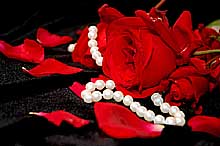| Home A B C D E F G H I J K L M N O P Q R S T U V W X Y Z |
|
Home |
Buying PearlsShopping For Pearls — A Crash Course on the
|
|||

If you are looking for a piece a pearl jewelry, you may find it a little overwhelming at first. You will encounter terminology like natural, cultured, freshwater, saltwater, and imitation. This may make it difficult and confusing at first. To help, this article will provide you some background information that explains the common types of pearls.
Natural pearls are just as they sound — pearls that are formed naturally without any human influence. Natural pearls are created by chance in nature as a result of an irritant becoming lodged in the tissue of a pearl bearing mollusk. Since the pearl shape is influenced by the shape of the irritant, finding a perfectly round natural pearl is extremely rare. For this reason, the majority of pearls sold today are cultured pearls, where the creation and characteristics of the pearl are influenced and controlled by humans.
Cultured pearls are typically identical to natural pearls except for how they begin. In cultured pearls, instead of the pearl forming by chance, a pearl farmer inserts an irritant into a pearl bearing mollusk, causing the formation of the pearl. The rest of the process of the actual formation of the pearl is the same as a natural pearl. Of course, by controlling the irritant, the pearl farmer can influence the shape, size, and color of the pearl created.
Freshwater pearls are pearls that are grown in freshwater rivers and lakes. These pearls are popular because they are an inexpensive genuine pearl that is extremely durable. Freshwater pearls can be either natural or cultured, although the majority on the market is cultured. The only weakness of freshwater pearls is that they typically do not share the same luster or perfect roundness as the saltwater pearls.
Saltwater pearls are pearls that are grown in saltwater seas and oceans. These pearls are typically more valuable than most other types of pearls because of their luster and beauty. Popular saltwater pearls include Akoya, Tahitian, and South Sea pearls. Saltwater pearls can be either natural or cultured, although nearly all of the market is cultured.
Imitation pearls, sometimes referred to as faux pearls, are man-made pearls. These pearls are manufactured from glass, plastics, ceramics, or other similar materials. Imitation pearls are typically sold as costume or designer jewelry and do not have any gem value.
These are some of the most common and popular types of pearls for the person just entering the pearl marketplace. Best of luck with your search!
Article Provided by Select Pearls.com:
Select Pearls provides fine pearl jewelry. Visit http://www.selectpearls.com for beautiful pearl necklaces, earrings, bracelets, and pendants. Genuine Akoya, Tahitian, South Sea, and Freshwater pearls.
| ALSO ON THIS WEBSITE: The Magic of Pearls Tahitian Pearls Buying Guide |
|
Glossary References Links Contact
|